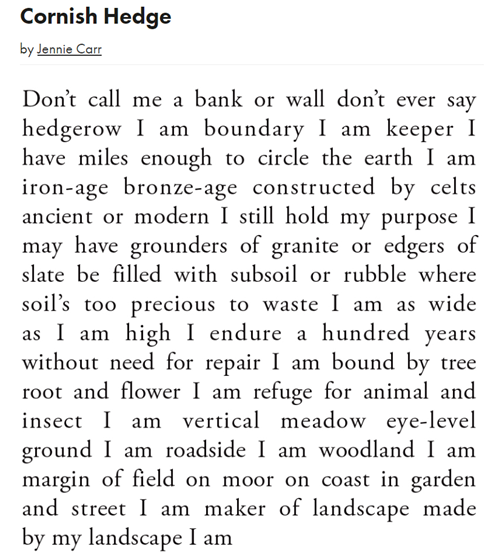Written by Henrietta Appleton, Policy Officer (England)
I have been delighted by the responses to my first monthly musings on hedges. Thank you. In my defence the initial blog was never intended to be all encompassing so I’m “hedging my bets” (pun intended!) and doing a follow up to acknowledge the excellent comments made.
Hedges have been a ‘pawn’ in wider agricultural policy and as one person commented, recent policy has been to re-plant hedges that were removed in the drive for extra production post-war, in support of nature recovery. Gapping up neglected hedges has also been a key driver in their restoration; although I am reminded of a wise former colleague who counselled against a 100% hedge length as gaps can provide butterflies with ‘escape routes’ when pursued by predators. The SFI Hedgerow standard specifies that gaps should comprise no more than 10% of the hedge. In my observational experience these gaps also gain more light and the resulting flowers and berries avoid the flail.
The management of existing hedgerows has also been supported by recent agri-environment schemes as opposed to just the planting of new hedges with rotational cutting encouraged to create a range of hedge heights and improve their biodiversity value. The range of heights is important as some species such as the yellowhammer and whitethroat favour short hedges (less than 2 metres); whilst taller hedges (over 2 metres) will increase the nesting opportunities for chaffinch and linnet. Given the comments flailing is obviously a point of debate as to its merits. But added to nature recovery is the role hedges can play in delivering net zero – the GWCT Allerton Project being recently centre stage on this with its work on the Hedgerow Carbon Code. This work identified that the litter beneath frequently flailed hedges increased the carbon content of the soil below the hedge.

The Poetry Society.
As with many management tools there are pros and cons and the problem with many policy initiatives is that they are simplistic, generating ‘black’ and ‘white’ pathways to follow. There is often little space for nuance for the individual. But as projects are demonstrating around the country, collaboration between land managers/farmers can create that all important diversity.
I mentioned the laying of hedges in my original blog and I acknowledge that this is a skill that requires time and effort. Before current funding for the planting and management of hedgerows (and woodland), often the motivation to retain the traditional techniques of laying/coppicing/pollarding/ dry stone walling in the face of policy demands was personal to the land manager and farmer (examples being provided in the comments). That motivation may have been that they saw themselves as the custodian of the landscape - or, quite simply, that they wished to keep their stock in the fields! But for hedges and trees it may also have been game management.
I remember reading a research paper by York University1 that identified a link between large estates, that became particularly prolific in the 18th and 19th Centuries, and our protected landscapes due to the management underpinning these land uses - "Estate landscapes have often maintained certain management regimes over long periods of time resulting in highly-valued biodiversity.” Many of these large estates were motivated by game interests such as deer and wild gamebirds. Hedges are ‘corridors’ for game and when wild partridges were the main sporting species, hedgerow design became a feature of a wild partridge estate. These were ‘designed’ not only to drive the birds over but also as nesting sites.
So all in all hedges are a vital ecological and cultural element in many parts of our landscape. They provide habitat and food sources for wildlife, create corridors to connect other habitats, provide shade for livestock (and in some cases are livestock proof), support carbon sequestration and provide a ’living’ perspective on the historical evolution of our landscape. This cultural aspect is epitomised in a more prosaic way than I could achieve by the Cornish Hedge poem repeated above.
1. Please note that the research paper focused on the influence of historic landscapes, of which game estates are a part, on conservation priorities. The full paper can be found here: Areas of Outstanding Nineteenth Century Beauty: Historic landscape characterisation analysis of protected areas in England - Stratigos - 2023 - People and Nature - Wiley Online Library (open access).